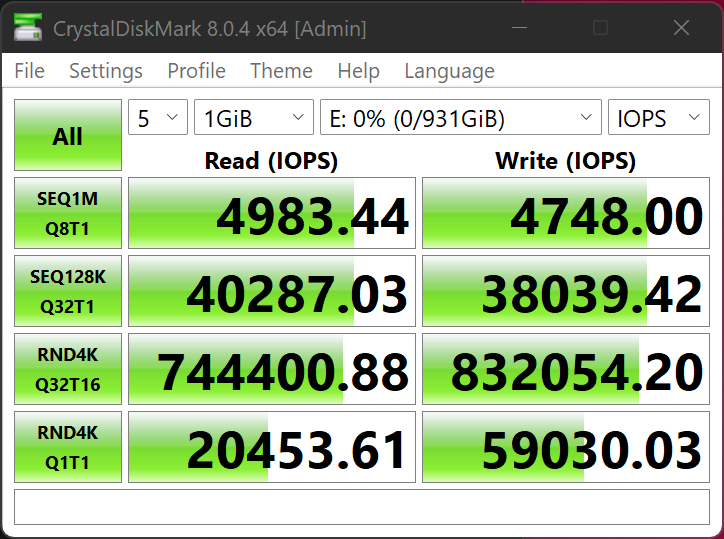
- #Crystal diskmark kuyhaa install#
- #Crystal diskmark kuyhaa serial#
- #Crystal diskmark kuyhaa 32 bit#
- #Crystal diskmark kuyhaa full#
- #Crystal diskmark kuyhaa download#
Going from a queue depth of one to 32 could result in 10 times the transfer speeds, which is massive. To use the filing cabinet analogy again, two people filing papers one by one will be much quicker than one person doing it by themselves. Having a higher queue depth often results in higher transfer speeds regardless of the block size or thread count, but a high queue depth makes an especially large difference in random workloads. You can imagine a queue as an individual worker filing documents away, and obviously, more workers mean faster filing. For sequential testing, we will be running two types of tests: the 1MiB Q8T1 and the 128KiB Q32T1, so we hope you can use the higher performance as its peak performance. By default, CrystalDiskMark tests at queue depths of 1, 8, and 32, though you can manually increase the queue depth and test that way if you wish. In addition, the benchmark conditions have also been revamped to reflect the latest PCIe 4.0-compatible SSDs’ performance. Queue depth refers to how many queues are handling I/O requests at any given time, and with more queues open to transfer data, there's a greater potential for faster transfer speeds. Although CrystalDiskMark uses large block sizes in sequential tests and small block sizes in random tests, block size isn't necessarily indicative of sequentialness or randomness. Sequential file transfers often involve large blocks, while random workloads tend to use smaller blocks. It's basically the difference between moving one piece of paper at a time and moving a whole folder into a filing cabinet.
#Crystal diskmark kuyhaa full#
I will not be putting the full drive name in list so people will have to find out from your post.
#Crystal diskmark kuyhaa serial#
list in your submission post the exact model of your drive even if its a long serial number. This might seem counterintuitive, but the larger the block size, the faster the transfer speed. press the 'All' button, the clickable speed link will show your picture, so even though I wont show it in the list, people will see it in your post. Depending on other factors, the performance difference between sequential and random can range from minor to extremely large. Random workloads involve data that isn't sequential or contiguous and may be spread all over the drive. In a sequential workload, the data the SSD is accessing is physically contiguous and can be accessed one after the other in a sequence (hence sequential). The main difference between these two kinds of workloads is how the data is organized. The two basic types of tests CrystalDiskMark uses are sequential and random, denoted by SEQ and RND respectively. random, block size, queue depth, and threads. CrystalDiskMark benchmarks come down to the four important testing parameters: sequential vs. Leaving it at the default of 1GB is completely fine, as it's a realistic size for a lot of data that you may access on your storage.ĬrystalDiskMark comes with four preset benchmarks, but if you look in the advanced settings, you can actually customize what the benchmark tests for and get different results. This is the file size that CrystalDiskMark creates to perform read and write tests on, and it ranges from 16MB to 64GB. It just works.Before running your tests, you'll need to set a working file size. Frequent releases and enhancements.ĭigitally signed code. Grub customization is done from Windows - Configuration in Linux is not required. Safely multiboot Windows, Remix, Android, Ubuntu, Debian, Suse, Fedora, Mint and more.

Supports extremely large (over 40 TB) disks and partitions. Works with both GPT and MBR disks - up to 128 primary partitions per drive. Works with all filesystems including Mac hfs and Btrfs.Ĭan search for and boot a partition by it's label. Preview and customize the 9 included graphic background themes. Lets you set your EFI firmware boot order from within Windows. Simple Windows GUI easily sets up Grub2Win in seconds. Boot time help is available in 31 languages. Requires just one directory on the Windows C: drive, about 18 MB disk space.
#Crystal diskmark kuyhaa 32 bit#
Supports 64 and 32 bit EFI as well as BIOS firmware.

If you find Grub2Win useful, please consider making a small donation to be used for hardware and testing. It is now used in 180 countries worldwide and has been downloaded more than 350,000 times. Samples for Remix, Android, Ubuntu, Debian, Suse, Fedora, Mint and Windows are included.
#Crystal diskmark kuyhaa install#
Using the simple Windows GUI and instructions you can install Grub2Win quickly and safely. On EFI systems 4 small modules are installed to your EFI partition.

Everything is contained in a single 18 MB directory on your Windows C: drive.
#Crystal diskmark kuyhaa download#
Here you can always download the latest version. Grub2Win boots native GNU Grub version 2 code. CrystalMark is a Storage benchmark and system information application from Crystal Dew World. Safely dual boot Windows and Linux from GPT or MBR disks. Grub2Win supports 64 and 32 bit EFI and BIOS on Windows 10, 8, 7 and XP.


 0 kommentar(er)
0 kommentar(er)
